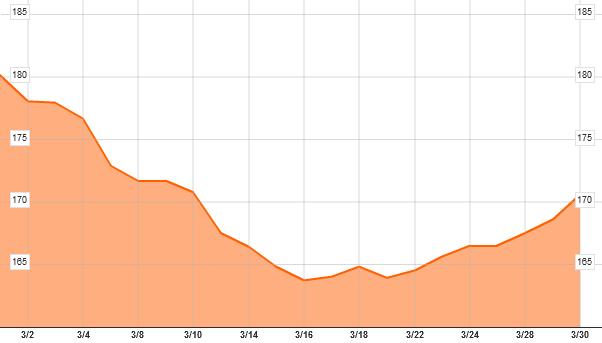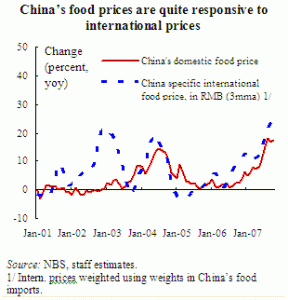The question I asked last week about Chinese growth and iron ore demand seems to have been answered for now. That question was the following:
Not only has the market not priced a significant, if cyclical, China slowdown, if it comes, Chinese steel makers may very well enter an inventory cycle that liquidates some portion of existing stocks.
Add that the impacts of Japan on global supply chains is much worse than many hoped, that the radiation crisis is resolving only slowly, and that the reconstruction effort will not get under way in earnest until the second half, and commodity markets are looking at a rather large demand gulf in the next quarter or two.
One has to ask, will markets be able to look across the valley?
Since then the market has indeed peered across the gulf, focussing on the distant green fields of Japanese reconstruction, not the wasteland that lies at its feet. The iron price has caught a serious and accelerating bid:

However, this bid has hit the market without any significant news from China. So the China slowdown/iron shock thesis still holds (and might just as easily apply to the Aussie dollar).
The iron ore bid appears to be part of a general shift back toward risk, a relief rally if you will, following the Japanese meltdown. This in itself amplifies the ongoing chances of a Chinese slowing. Oil and grain futures surged last night and, as I have argued before, Chinese food price inflation is responsive to international movements in grain prices:

And the FT reported lower US stockpiles of wheat and soyabean that previously thought:
Corn and soyabean prices surged on Thursday after the US government said inventories were even lower than earlier believed, suggesting that supplies will fall to critically low levels before the northern hemisphere harvest.
The declines in grain and oilseed stocks suggest that demand – from livestock farmers in developed and emerging markets, and from the ethanol industry for corn – has not yet been tempered by surging prices over recent months.
Corn prices have gained nearly 52 per cent and soyabeans 34 per cent since the beginning of 2010 on strong demand for animal feed, especially from China.
Higher prices have prompted farmers in the US, the world’s largest exporter of agricultural commodities, to plan to increase planting. But the increase probably would not be enough to rebuild stocks to comfortable levels, analysts said.
The US Department of Agriculture said 6.52bn bushels of corn were stored in farmers’ bins and traders’ grain elevators at March 1, 15 per cent less than last year and some 170m bushels less than market expectations. Soyabean stocks fell to 1.25bn bushels, 2 per cent less than last year and lower than expected.
The agriculture department had already expected corn stocks to fall to the lowest levels in more than a decade before this year’s harvest. Thursday’s reports suggested these leftover supplies will drop further, pushing prices higher.
CBOT May corn futures rose by the daily trading limit of 30 cents to $6.93¼ a bushel. Corn prices set an all-time high of $7.65 a bushel in June 2008. CBOT May soyabeans gained 60 cents to $13.68½ a bushel, as trading resumed in the wake of the report’s release. Wheat prices also rose sharply.
Darrel Good, agricultural economist at the University of Illinois, said the data suggested that “we really have to slow consumption of corn over next five months. We have to slow consumption in an environment of record high livestock prices, an explosion of export sales of corn and very favourable ethanol production margins.”
High prices will prompt farmers to plant 5 per cent more land with corn this year than in 2010. At 92.2m acres (36.9m hectares), this would be the second-largest expanse of corn fields since the the second world war.
But corn’s gains will come at the expense of land for soyabeans, which will shrink 1 per cent to 76.6m acres, the USDA said.
The data suggest US farms, which provide the bulk of the world’s surplus supplies, may not be able fully to replenish scarce supplies this growing season. The more than 85,000 farmers surveyed by the USDA indicated they would plant a total of 253.9m acres in eight major crops, 8.6m acres more than last year but less than the 10m gain that the department’s models had forecast last month.
Nor is there likely to be any near term respite in the oil price. Again from the FT, US Secretary of Defence, Robert Gates, is warning that the easy gains in the Libyan campaign are over:
Nato faces a protracted conflict in Libya, the US’s top two military chiefs signalled on Thursday, even as they promised that Washington would substantially scale down its participation in coming days.
Robert Gates, defence secretary, and Admiral Mike Mullen, chairman of the joint chiefs of staff, acknowledged the possibility of a stalemate as they sought to square growing congressional discontent about the military action with Libyan rebels’ calls for more aid to prevent a rout by Muammer Gaddafi’s forces.
Asserting that Col Gaddafi’s tanks and armoured vehicles still outnumber the disorganised opposition forces by 10 to one, Adm Mullen said allied airstrikes had so far reduced the Libyan leader’s forward forces by 20 to 25 per cent.
But he added: “That doesn’t mean that he’s about to break from a military standpoint because that’s just not the case . . . He’s got mobility. He’s got the training. He’s got command and control, communications, a lot of which the opposition just doesn’t have.”
Appearing at hearing of the House of Representatives Armed Services Committee, Mr Gates said: “We have considered the possibility of this being a stalemate and being a drawn-out affair.” He said there could be an outcome “where you achieve the military goal [of establishing a no-fly zone and protecting civilians] but not achieve the political goal” of ousting Col Gaddafi.
In summary, there is plenty of ongoing motivation for Chinese authorities to keep pressing the brake. With the Australian dollar running wild and free, the markets look completely unprepared for a China slowdown.
The other of our ongoing risk themes has been Europe. On this I’ve been more sanguine and, like the markets, remain so. The latest Irish debacle failed to stir even a $US response. I’ve been positive basically because Ireland has all the cards. That is, it’s broke (what a world!). So Europe will have to bail it again to protect its delicate and interconnected banks. However, the BBC does today have a salutary piece on how a new round of bailouts could fail:
1) Tomorrow Ireland publishes the results of bank stress tests. It has to find – or the EU has to find – another E18-25bn to shore up its failing banks.
2) It goes to Brussels and demands what it asked for three weeks ago and failed to get: better terms, lower interest rates, greater forebearance from the bailout fund that is keeping its banking system alive (or I should say actively zombified)
3) Meanwhile in Lisbon they do the same, or try to – hampered only by the fact that the government just lost its parliamentary majority (and parliament may be dissolved Thursday).
4) Meanwhile, in Greece, beset by continued downgrades of their credit rating and declining prospects of being able to grow their way out of fiscal crisis, they join in the clamour for a more generous deal.
5) Meanwhile in Helsinki, voters go on ticking the box on opinion poll questionnaires that is marked “True Finn”: Finland is stymied from putting up its share of the proposed bailout fund because parliament is dissolved: after 17 April, if the True Finns (leader, Millwall fanTimo Soini) join a coalition with the centre right, they may stymie the new mechanism full stop.
6) It all points towards the thing the EU leaders have been trying to head off since the December crisis: a chaotic default on peripheral debt, blowing apart the carefully crafted compromises that have allowed the interim bailout mechanism to work.
7) Then the question is – if Ireland, Portugal and Greece default – how much the governments of northern Europe are on the hook for? Because it is big European banks – in Spain, Germany, France and, oh, Britain – that will see their loans go up in smoke in any default.
There’s quite a few “ifs” in there but let’s not forget the lesson of the US when it sought to bail out its banks through the TARP program. Although the fiscal package was passed, it was first voted down. Politics can definitely derail assumed solutions.
In the event that it does go this way, make no mistake, it’ll be panic stations everywhere. Bloomberg has a good description of the outcome but also a good argument for why it’s unlikely:
Ireland making good on its threat to impose losses on senior bank bondholders would precipitate a funding crisis for lenders across southern Europe, according to CreditSights Inc.
“The fallout would be big and it would be bad,” said John Raymond, a London-based analyst at the independent research firm. “The senior unsecured market would shut down, at least for a while. Right now, the bigger and better Spanish and Italian banks can still access the market. That could end.”
Pressure on bondholders to share the burden of banks’ losses is growing. In Denmark, the government inflicted so- called haircuts on senior creditors and depositors of regional lender Amagerbanken A/S, which failed after losing money on investments including real-estate loans. Moody’s Investors Service cut ratings of five Danish banks, including Danske Bank A/S, the country’s biggest, pushing up funding costs. Ireland’s government has similar powers to Denmark’s under the terms of its banking act.
… In the short term, subordinated debt is a more-likely candidate for burden sharing than senior bonds, said Tom Jenkins, an analyst at Jefferies International Ltd. in London.
“Subordinated debt is another matter,” he said. “A coercive tender for the sub out there would be no surprise at all and that’s reflected in its price.”
…The government’s guarantee would be triggered if the senior bonds were written down, forcing the administration to pay off those notes, according to Stephen Lyons, an analyst at Dublin- based securities firm Davy. Added to that, the senior bonds were largely issued under English law, meaning bondholders would have recourse to the English courts for protection, he said.
Irish threats to haircut senior creditors are a negotiating ploy, he said.
“What we give up is the threat of burden sharing,” he said. “By focusing the headlights on the need for burden sharing, we get the funding line we need for the banks. That prevents a fire sale which would trigger losses. It’s a threat we can’t use but can trade — it focuses negotiations on a bank funding line.”
In terms of the Aussie, these issues are currently risks not realities. And as Deus Forex Machina reminds us, our currency sits at the epicentre of the post-Japan risk-on inflation trade.
In his colourful language, nobody is a seller right now because they don’t want their “arse handed to them on a platter”. It’s better to wait until something happens, then run for the exit. Of such conditions, true blowoffs are made.

